|
 |
■Bioresources information is available at the following URLs
|
 |
|
Introduction to Resource Center <No. 44> Diversity and Resource Project of Yeast Flora in Japan Based on
the Comparison between the Data of Yeast Species Isolated from
Iriomote and Rishiri Islands
Masako Takashima & Moriya Ohkuma
Japan Collection of Microorganisms(JCM), RIKEN BioResource Center
Isolation of 183 Yeast Species
from Plants and Soils |
The islands of Japan stretch from the subarctic to the subtropics, and their geographical features extend from the south to north. Different types of vegetation exist in different areas, because of which there is abundant diversity among the microorganisms living in Japan. Therefore, Japan is considered rich in microorganism resources, such as yeast. However, microorganism resources have not yet been comprehensively investigated.
To understand the diversity and distribution characteristics of yeast flora in Japan, 1,021 yeast strains were isolated from soil and plant samples collected in Iriomote Island in Okinawa Prefecture and Rishiri Island in Hokkaido Prefecture. These isolates were analyzed using the partial sequence of a gene that codes for ribosomal RNA (the D1/D2 domain of the large subunit (LSU) rRNA gene, which is widely used for the identification of yeast species and hereinafter referred to as the D1/D2 domain). Based on this sequence, these isolates were classified into 183 species. This number is equivalent to 14% of the number of yeast species (1,312 species) registered in the fifth edition of The Yeasts: A Taxonomic Study (2011), a standard reference book on yeast taxonomy at present, indicating that a wide variety of yeast species exist in Japan. Approximately half of the 183 species were estimated to be new species. Moreover, only 15 species were isolated in both Iriomote and Rishiri Islands. A significance test∗1 based on the sequence data showed that yeast species in Japan differ considerably according to the area inhabited.
|
Proposal of an Index at the Genus Level Based on Base Sequences
For the conservation of biological diversity and the continuous use of biological resources, organisms should be analyzed at the genus level, which is one rank higher than species in taxonomy. However, in the current classification of yeast, even when a yeast strain is found to be a new species, the genus to which the yeast strain belongs cannot be identified based on its base sequence owing to the problems existing in the classification system. Therefore, the diversity of yeast is difficult to estimate at the genus level or higher. In the ecological analysis of bacteria, a method has been introduced in which bacteria with sequence similarities below 95% in the 16S rRNA gene are considered different species (Ludwig et al., 1998). However, this method has not yet been applied to the ecological analysis of fungi.
Recently, we proposed a method, in which the D1/D2 domain was analyzed using yeast species that belonged to the genus Saccharomyces, which had been reclassified based on multigene analysis, and allied yeast species (the family Saccharomycetaceae), and the results were compared with each other to clarify the diversity of yeasts at the genus level. In this method, the D1/D2 domain was used as an index of the similarity between base sequences. A rarefaction analysis∗2 using the index values as thresholds showed that yeast isolates exhibited unique patterns according to the sampling location and the isolation source. Thus, the diversity of yeast differed greatly according to the area where the yeast was isolated at the genus level or higher. Using the index, approximately one-sixth of the species isolated in this study were revealed as candidates for new species. |
Development of "General Microorganisms" Resource Project
The "general microorganisms" resource project, which handles various resources of bacteria, archaea, yeasts, and filamentous fungi, must provide resources with the correct scientific names. As is already known, the International Code of Botanical Nomenclature was revised in 2011 (Melbourne Code∗3). Consequently, dual nomenclature, which has been used for higher fungi including yeasts—according to which genera and species of ascomycota and basidiomycota, whose polytypic life cycles and morphologies coexist, are pragmatically classified and differentiated using different scientific names in the sexual and asexual stages—has been shifted to unified nomenclature (one scientific name for one species). Consequently, some scientific names currently used for yeasts and filamentous fungi will be changed according to the list that will be created by the International Nomenclature Committee. Therefore, we will revise our online catalogue of strains, in which yeasts and filamentous fungi can be searched for using both their current and new names. When a new species that belongs to a new genus is discovered, similar to our study’s methods, a scientific name must be given to the new genus. For this, we are attempting to construct a system to classify genera based on genome sequence data.
We will successively publish strains used in the present study from JCM at http://www.jcm.riken.jp/.
| |
∗1: |
A statistical method to confirm the difference between two groups. |
| |
∗2: |
A method to extrapolate biological diversity based on sampling results. |
| |
∗3: |
International Code of Nomenclature for algae, fungi, and plants (Melbourne Code)
http://www.iapt-taxon.org/nomen/main.php
|
|
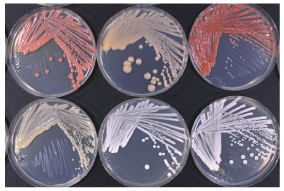
Photo: Yeast strains isolated from plants in Iriomote Island |
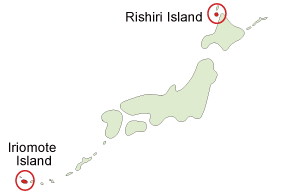
Fig. : Rishiri and Iriomote Islands |
This study was performed based on "Comparing the microbial diversity in subtropical and cold latitudes in Japan with the goal of establishing a database for microbial inventory," the first Research Grant awarded by the Institute for Fermentation, Osaka.
|
References
Takashima, M, Sugita, T, Van, BH, Nakamura, M, Endoh, R, Ohkuma, M. (2012) Taxonomic richness of yeasts in Japan within subtropical and cool temperate areas. PLoS ONE 7 (11): e50784. doi:10.1371/journal.pone.0050784 |
|
|
Let's Customize NCBI ! (How to use My NCBI) |
|

Most of you may have used the National Center for Biotechnology Information (NBCI) website, www.ncbi.nlm.nih.gov, which hosts services such as GenBank and PubMed. In February 2005, NCBI released its personal portal service, "My NBCI," which allows users to customize the many services NBCI provides. The portal service currently includes the following functions.
| |
|
|
| • |
An ability to save specific search results or an option to receive them periodically by email |
|
| • |
Choice of format for displaying search results; for example, the default format for the Nucleotide database is in the GenBank format, which can be changed to FASTA or others |
|
| • |
An option to filter search results using your own filter; wherein you may filter sequences of bacterial origin and genome sequences belonging to the Nucleotide database, or filter using publications linked to Online Mendelian Inheritance in Man (OMIM) |
|
| • |
Users can manage their own publications and obtain a URL for making such a collection publicly accessible. Information on publications not registered on PubMed can also be added |
|
| • |
Choice of format for highlighting matching keywords in a search, such as choosing the default bold highlighting or yellow background highlighting |
|
| • |
The website retains browsing history for 6 months, allowing users access to previous searches if required |
|
| • |
Results from any recent BLAST searches that users have performed may be accessed later |
|
| |
|
|

In order to login to My NCBI, click on the "Sign in to NCBI" link located on the top right-hand-corner on the home page∗1, after which a sign-in form will be displayed. Even if you do not have an NCBI account, you may use your Google or NIH account to sign in.
| 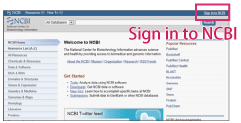
Fig. 1. NCBI home page |

My NCBI has undergone a redesign in 2011, which allows you direct access to the functions provided by My NCBI. Please do try out the functions introduced here.
Additionally, windows for each function can be moved by drag-and-drop, or minimized.
This introductory video ∗2 (My NCBI Home Page) is available on YouTube. Those of you wishing to know more about My NCBI should refer to the help page ∗3.
(Kimura Gaku)
| 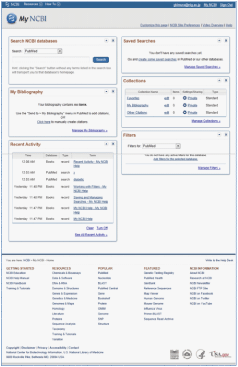
Fig. 2. My NCBI home page |
|
|
|
|
Drosophila Genetic Resource Center "DGRC"
|
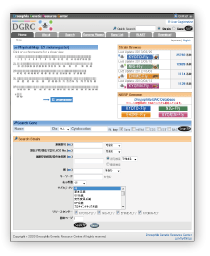
・Number of strains: 40,651
・Number of genes: 15,584
(As of March 2013) |
| DataBase name: |
DGRC |
| URL: |
http://www.dgrc.jp/ |
| Language: |
Japanese, English |
| Original contents: |
Drosophila melanogaster (wild type, mutant, and RNAi-exposed strains), wild-type strains of Drosophila species in Japan, mutant strains of allied Drosophila species, genome information of D. melanogaster, genome viewer, sequence cutter, etc. |
| Features: |
・Resources provided by the institutions involved in the National BioResource Project (NBRP)- Drosophila (National Institute of Genetics, Kyoto Institute of Technology, Ehime University, and Kyorin University) can be searched collectively.
・Genome information of D. melanogaster can be compared with the insertion and deletion loci of each strain using the genome viewer. By clicking the marker of a strain, the distribution of the strain can be continuously requested. |
| Cooperative DB: |
KYOTO-FLY, NIG-FLY, EHIME-FLY, KYORIN-FLY |
| DB construction group: NBRP-Drosophila, NBRP Information |
| Management organization: Genetic Resource Center, NIG |
| Year of DB publication: 2007 Year of last DB update: 2013
|
|
Comment from a practicing developer: The information of the strains registered in DGRC is updated every day based on information from the institutions involved in NBRP-Drosophila; therefore, please use this database as a window to your search for strains of Drosophila species. Since markers of strains on the genome viewer in DGRC are mutually linked with detailed pages on those strains in the KYOTO-FLY and NIG-FLY databases, the resources available for a gene of interest can be easily searched.
Please feel free to contact us. We welcome suggestions and requests via the "Contact Us" link on the upper right part of the website.
|
|
|